As you might notice, this is the third post about the
abandoned railroad in High Springs, FL (the previous posts are here and here). This is partly due to my obsession with old railroads
in general, partly because I live in High Springs, and partly due to the fact
that there’s just some fascinating stuff out there if you know where to look. During
our previous explorations of the rail line, we were mainly just following the different
sections of old railroad bed, looking to see what we could find. We knew that
there had been a large railroad presence in High Springs at one point –
complete with a roundhouse – but we didn’t know where any of the facilities had been
located. It turns out that we had walked within a few feet of the remains of
the roundhouse and other rail yard buildings without knowing it; it’s amazing what
mother nature can hide.
A couple of weeks ago we decided to check out the High Springs Historical Museum to see if they could tell us where the roundhouse had been located – and they
knew exactly where it was (and where its remains still are). We, of course,
immediately began planning to go and find it.
But first I should probably give you a little background. I
mean, first off, what’s a roundhouse? Wikipedia
has a pretty informative article, complete with pictures of a variety of
roundhouses, which should fill you in. Back in the days of steam locomotives,
roundhouses were pretty common. They were a way to get multiple train engines
off of a limited number of tracks and into garages for maintenance, involving a
gigantic turntable with a piece of track on it. This article from American Builders Quarterly details how a
roundhouse is constructed. It’s also where I found the following picture, which
gives you a good idea of how a roundhouse should look.
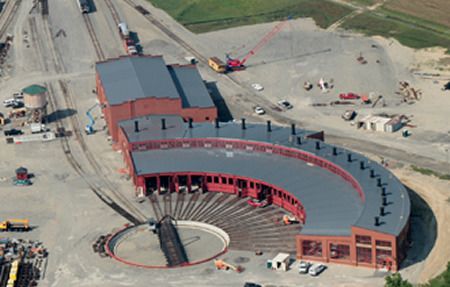
The locomotive reaches the circle in which the tracks mounted on a turntable are located. The train rolls onto the turntable-mounted tracks, which are then rotated to line up with the tracks for the specific 'garage' into which the engine needs to go. Ingenious, really.
(Photo from American Builders Quarterly)
High Springs of today is a quaint, laid back, small town.
There’s little in terms of industry nowadays; the community’s big draws are
nature-based tourism and antiquing. However, back in the 1890s during the heyday
of steam powered rail, High Springs was a bustling center of railroad industry.
In 1895, High Springs became home to the division headquarters of the Plant System Railroad Line. By
1896, a roundhouse and a maintenance shop for steam locomotives had been
erected – as well as a hospital, homes for railroad workers, and the various trappings
of city life in the late 1800s. The population of the community swelled as
railroad lines were added and the locomotive maintenance facilities grew more and
more active. The roundhouse was rebuilt and enlarged in 1928 to accommodate the
demand. Then the diesel engine was invented. By the end of WWII, use of steam
locomotives began to dwindle, and the need for rail yards designed specifically
to service steam engines declined. The High Springs Historical Museum has a
photograph of the roundhouse in action in 1950, but it did not remain in use
long thereafter.
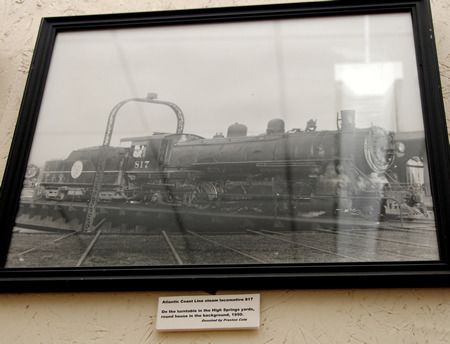
Photo exhibited in the High Springs Historical Museum, taken in 1950
If you’re familiar with modern-day High Springs, you’ll know
that the present day center of life in town is roughly two blocks of Main Street straddling Hwy 27, between 441 and the old railroad bed. As this
is the focal point of today’s High Springs, I had assumed that the rail yard
would have been right there, too, or perhaps just a couple blocks to the north,
where the peanut plant is located. It turns out that the massive rail yard was
far too large to fit neatly next to downtown High Springs. To find what remains
of it, you actually have to head thirteen blocks northwest of Main
Street.
On the one hand, it’s surprising how little remains of what
was once such an enormous and thriving enterprise. On the other hand, there are
a lot of interesting remains of the facility if you know where to look. Just to
the northwest of the former junction between the line connecting High Springs
and Newberry with the line connecting Fort White to High Springs to Alachua is
an area of undeveloped land which, while overgrown with brush, is not quite as
overgrown as one might expect of rural north Florida. Instead of majestic old
growth oak, one finds smatterings of spindly new-growth oak, surrounded by
blackberry bushes and other prickly weeds.
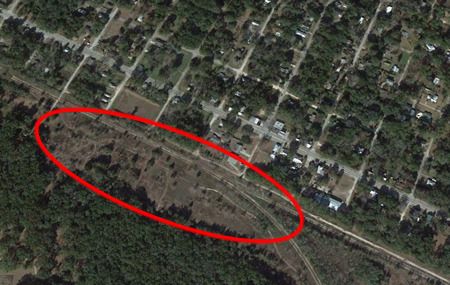
This empty, desolate stretch of land was once the economic heart of High Springs.
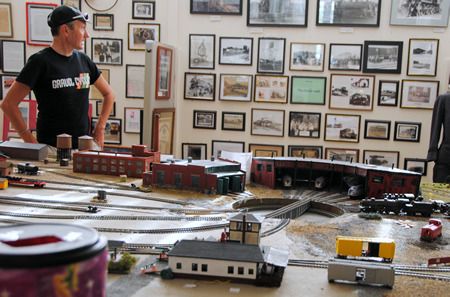
(That's JOM of GravelCyclist, by the way.)
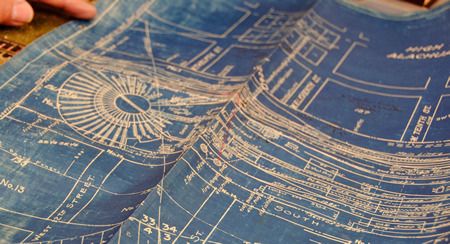
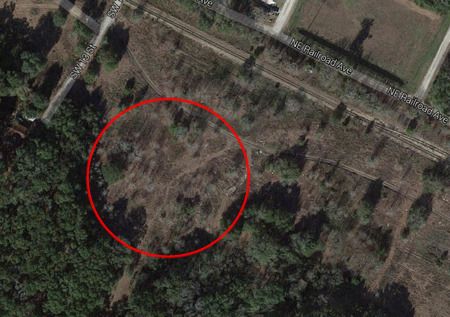
....which places it roughly there.
The remains of the rail yard are hidden under brush and
brambles – as I mentioned above, we had previously walked within several feet of some of them without spotting
a single thing – but if you pay close attention and know where to cast your gaze, you can still find the remains.
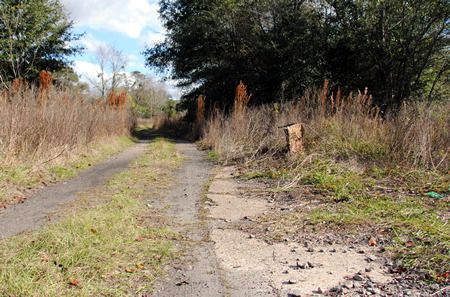
Much of the yard was once paved in concrete, and quite a lot of it remains, although it's mostly covered by a thin layer of dirt and vegetation. Here you can see a tantalizingly curved section of concrete, perhaps marking the edge of the roundhouse.
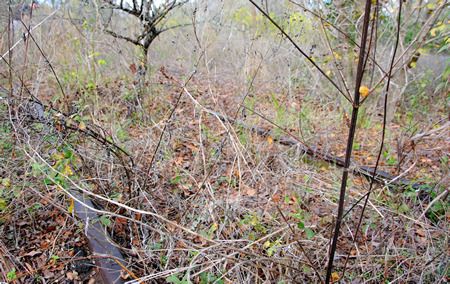
Here and there in the brush, you can still find sets of train tracks...
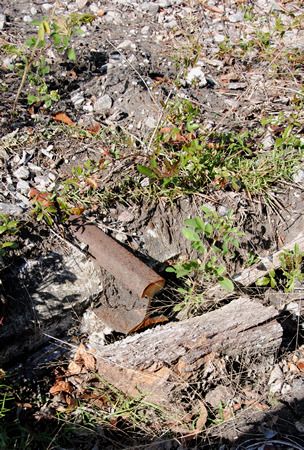
...the rails of which are abruptly truncated.
This makes a lot of sense if you think about the roundhouse structure.
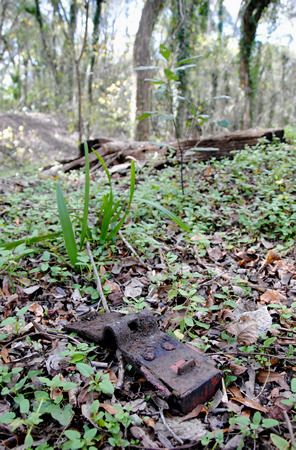
Railroad detritus is scattered throughout the area.
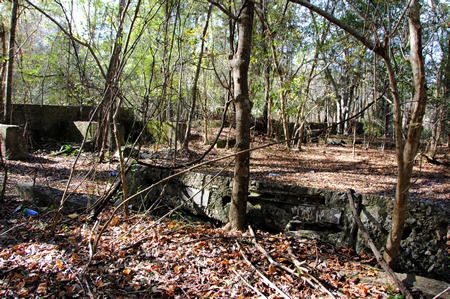
What I believe would have been machine shops
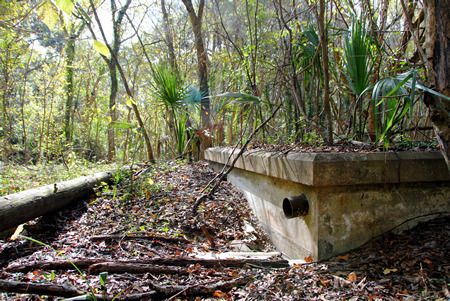
Part of the old hospital
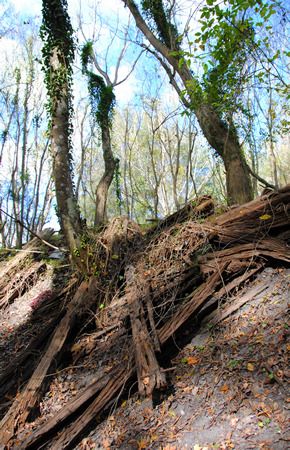

I have to the rail yard also.
ReplyDeleteDid you find the two sets of footings from the water towers?
I am a director at the mueseum.
I built the two water towers on the diorama.
Thank you for your posts